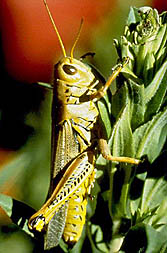This page has been archived and is being provided for reference purposes only. The page is no longer being updated, and therefore, links on the page may be invalid.
|
|
Grasshoppers Can Transmit Virus to Livestock
By Laura McGinnisAugust 26, 2009
Rangeland plants may be harboring a virus that grasshoppers are transmitting to cattle, horses and other hoofed mammals, according to a published research study by Agricultural Research Service (ARS) scientists.
A recent outbreak of vesicular stomatitis virus (VSV) in the southwest United States has disrupted rodeos and prompted quarantines. VSV is a viral disease that causes sporadic outbreaks in the United States, most recently in 2006.
Barbara Drolet at the ARS Arthropod-Borne Animal Diseases Research Laboratory (ABADRL) in Laramie, Wyo., and Justin Derner at the ARS High Plains Grasslands Research Station in Cheyenne, Wyo., have shown that under laboratory conditions, rangeland plants can harbor VSV and pass the virus to grazing grasshoppers.
This research, published recently in the journal Applied and Environmental Microbiology, is the first to demonstrate the stability of VSV on rangeland plant surfaces.
Although rarely fatal, VSV causes painful blisters on cattle, horses and other hoofed mammals. During outbreaks, infected animals salivate heavily and shed virus, which results in direct animal-to-animal transmission. Soil and plants have been hypothesized to be virus sources, but current recommendations for VSV control do not include decontamination of corrals and pastures.
To determine the window of opportunity for grasshoppers to ingest viable VSV from contaminated plants, Drolet and Derner selected 14 rangeland plant species that grasshoppers eat and exposed the plants to VSV in a laboratory setting. In the lab, several species harbored viable virus for up to 24 hours.
The scientists then exposed two plant species to VSV and fed them to grasshoppers 24 hours later. The grasshoppers became infected. These results support the hypothesis that grasshopper-cattle-grasshopper transmission of VSV is possible.
The scientists next tested a common grasshopper pesticide and found that, in addition to reducing the grasshopper population, the pesticide inactivated VSV upon contact, thereby reducing a source of virus for livestock and grasshoppers. Although such use would require additional U.S. Environmental Protection Agency registration, the pesticide—or a similar virus-inactivating spray—might help limit VSV outbreaks.
The results of this study could be useful in making disease management decisions during future outbreaks, not only by offering a potential control method, but by making it possible to assess risk more accurately.
ARS is the principal intramural scientific research agency in the U.S. Department of Agriculture.

